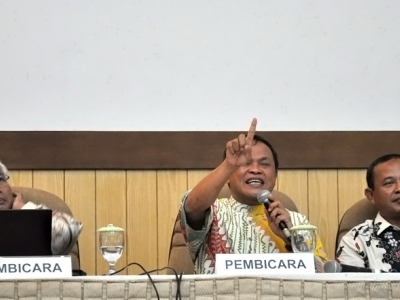Establishing Wayang as Media for Humanity Enlightenment

Members of Javanese traditional society are very fond of wayang purwa (classic leather puppet)’s stories and shows. In that precious cultural heritage of Indonesia, life of mankind is depicted as a shadow in which life experience and life purposes one by one take place in certain stages. The life of mankind goes on in an undeniably given pattern. Therefore, themes in wayang are certain and far from possibilities.
Wayang dynamics and dialectics when being played by a dalang (puppeteer) in a wayang show is a reflection of the life of mankind in this world. The dalang gives directions of how we should live to fulfill our tasks of living. Therefore, watching wayang show as well as reading wayang stories can become identification processes with certain characters to reflect ourselves and take examples from the characters to behave in our daily lives.
That was the statement of Prof. Dr. Suminto A. Sayuti, a professor of the Faculty of Languages and Arts of Yogyakarta State University in a National Seminar on Wayang as Media for Humanity Enlightenment in the Main Convention Room of YSU Rectorate Building, on Saturday (5/11). He added that wayang was an ideological site in which various ideologies clash, eliminate as well as complete and enrich each other in order to create balance in performance aesthetically framed harmony. “Sociologically, wayang can play its communicative functions. It means that wayang show can be propaganda for many things in line with wayang’s capability and authority as a work of art,” he stated.
“Through wayang shows, the audience can achieve various values other than the entertainment values, for example, a philosophically transcendental value. Certain acts are intentionally chosen and prepared so that both kinds of values can enrich each other.” The seminar was conducted in the Indonesian Educational Museum (MPI) to celebrate YSU’s 49thdies natalis. It invited some speakers such as Prof. Dr. Suminto A. Sayuti, Ir Yuwono Sri Suwito (the Chairperson of the Cultural Board of Yogyakarta Special Territory), and Kirun (an artist).
Meanwhile, according to the Head of MPI YSU, Sardiman, this activity was conducted because wayang, as a precious cultural heritage, was not greatly appreciated by Indonesian young generation and scientists. Therefore, it was possible that this precious art would be replaced by foreign culture products. “It will be ironic if we, as Indonesians who own this precious heritage, do not appreciate it while many foreign artists and scientists have analyzed and developed the art of wayang in Indonesia,” Sardiman explained.
Meanwhile, Ir. Yuwono Sri Suwito argued that wayang was a masterpiece of Indonesia which should be preserved not only its physical figures but also its symbolic, philosophical, moral, and ethical values. Furthermore, UNESCO also established wayang kulit show as a Masterpiece of Oral and Intangible Heritage of Humanity in 7 November 2003.
“At first, the function of wayang show is to honor the spirits of ancestors as a complementary thing in ritual or traditional ceremonies. However, along with era development, this function changes. These sacred values of wayang show change to be functioned as guidance in character education, educational philosophy, and soul enlightenment. Then it changes again only to be a form of entertainment although it is bounded by pathet (rules).
In this globalization era, wayang show as a traditional art has developed into a pseudo traditional art. Meanwhile, Kirun stated that Indonesians were nations with originally good behavior based on hereditarily inherited religious and cultural values.
“We are now in an era called postmodern in which there is an unbalanced fight between dominant cultures supported by local market and local cultures defended by their owners. There has been an anxiety that many nations in the world lost their precious cultures. Therefore, we should anticipate it by strengthening nationalism through implementing local wisdom such as spiritual culture, natural heritages, and cultural heritages,” he closed. (dedy)

